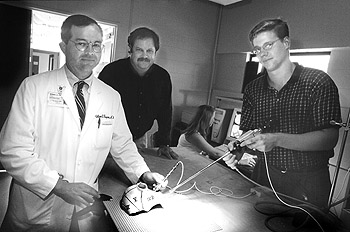New technique may help surgeons navigate within liver

The VUMC team developing the new surgical imaging technique includes (from left) Dr. William Chapman, Robert Galloway, Ph.D., and Jim Stefansic, graduate student. (photo by Donna Jones Bailey)
A technique being developed at Vanderbilt University Medical Center could soon allow surgeons to perform delicate abdominal surgeries that are far less invasive than current methods.
The technique makes use of existing imaging technologies, such as magnetic resonance imaging (MRI) and computed tomography (CT), which have long been used for diagnostic purposes and for procedures involving the brain.
Now, VUMC scientists are pioneering a way to use these images during therapeutic procedures in other parts of the body, much in the way that mammography can now be used to guide minimally invasive breast tumor biopsies and excisions.
The technique – detailed in a study published recently in the Archives of Surgery – could allow surgeons to see exactly where their instruments are located in the liver while they are operating, an ability that, until now, has been elusive.
"What we would anticipate is using our image guidance to guide us to a spot right in the middle of the tumor, where we can remove the tumor, or kill it with ablative techniques," said Dr. William C. Chapman, associate professor of Surgery.
The same technique has long been used to help remove tumors in the brain, where it is vital that surgeons know exactly where their instruments are located and what structures in the brain they are close to.
"What made this a little bit easier in intracranial surgery is that the markers that match the tomographic images with the real life brain can be attached to a fixed position on the skull," said Robert Galloway, Ph.D., associate professor of Biomedical Engineering.
Matching points in the patient's brain and the image maps created by CT or MRI scans is accomplished by the use of either a stereotactic frame or fiducial markers, which are attached to the patient's skull. Once the frame or markers are in place, scans are taken and the various points in the brain, including tumors, are given coordinates defined by the frame or the makers.
Once the brain has been mapped – a process known as registration – surgeons can plan a route that will take them to a tumor site with a minimum of damage to the brain's vital structures.
Until now, this method hasn't been an option for liver surgeries because the abdominal cavity, unlike the skull, is not a rigid, fixed, easily mapped shell.
"What you have is a bunch of organs that move and shift position with respiration and body position, so it is not the kind of environment that you can attach a fixed reference to and expect to be accurate," said Galloway.
What researchers have done to overcome that problem is to use the liver itself as a reference point between the patient and the imaging technology.
"We run an instrument over the surface of the liver which takes measurements as it moves. Those measurements are used to determine exactly where on the liver the probe has been placed," said Galloway.
The imaging software then reconstructs the rest of the patient's liver according to where the surface of the liver lies.
In addition to finding reliable points on which surgeons can base their registration methods, researchers are also struggling with the fact that the liver moves during respiration.
Chapman and Galloway's most recent research set out to measure the change in the liver's position during respiration.
"Previous investigators have designed imaging methods to estimate the movement of the liver and other organs, but this represents the first method where liver movement has been able to be directly measured in a precise way," said Chapman.
Once the researchers have determined the position changes of the liver, it is hoped that they will be able to begin using the image guided surgery system to position a probe within two millimeters of a target site in the liver.
"In this way we could accurately follow our working location on CT and MR images. This would allow us to precisely define our planned liver resection margins or probe placements for cryoablation," said Chapman.
The freezing sphere generated by the probe attempts to create a one-centimeter margin around the tumor, so placing the probe in the exact center of the tumor is very important.
"If you are off on any plane when you place the probe, you can miss part of the tumor and do damage to healthy liver cells, which is also a problem. So we hope that this technique will allow us to be more accurate with probe placement and also less invasive," said Chapman.
One of the reasons for the project's initial success has been the close collaboration between researchers in the departments of Surgery and Biomedical Engineering. Dr. Alan Herline, a senior Surgery resident, has spent the past two years working with Galloway and Chapman on the project.
"His background in biomedical engineering and his surgical experience have allowed him to bridge the divergent experiences of all the investigators involved in the project," said Chapman.













